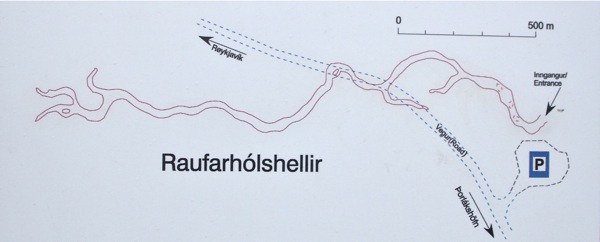Raufarholshellir EarthCache
rjm1: Sadly this cave has now been locked so the owner can charge tourists for a guided tour.
-
Difficulty:
-

-
Terrain:
-

Size:  (not chosen)
(not chosen)
Please note Use of geocaching.com services is subject to the terms and conditions
in our disclaimer.
Please note there is no need to enter the lava tube cave in order to fulfil the requirements of this cache. The answers can be gained whilst standing outside of the cave entrance.
If you do choose to venture in further be advised that the cave is quite difficult to explore. For your own safety use a good and reliable light-source, hat or helmet and good shoes and gloves.

The Entrance to Raufarholshellir
Lava Tubes
Lava tubes are a typical primary cave where the space is formed together with the surrounding rocks and is not the product of erosion. Other types of primary caves include blister caves (volcanic gas bubbles), tufa caves and reef caves.
Lava tubes are a natural underground conduit that lava flows through from an active volcano. The volcano must produce fluid lava flows so pyroclastic volcanos (explosive eruptions) do not usually result in one. The tubes can be formed in two ways. The surface of the flow cools sufficiently to harden leaving the hotter interior fluid still flowing. Alternatively, other material can accrete to the outside of the flow and form the tube-like structure around the flow. The good insulating properties of hardened lava means they can carry the molten material long distances. For example, Kazumura Cave on Big Island in Hawaii is over 61km long.

Map of Raufarholshellir
Raufarholshellir
This lava tube is 1360m long, 10-30m wide and up to 10 metres high. The roof averages 12 metres in thickness. The lava field the cave was formed in was the product of a fissure eruption around the year 1000.
Raufarholshellir is also an ice cave. The term ice cave refers to any natural cave that contains a significant amount of ice all year round. A portion of the cave must have a temperature of below 0 degrees Celsius and have water present. There are a few processes that result in the cave temperature being lower than the surface temperature. In this case, a cold trap is the cause. Cold dense air flows into the cave and cannot escape easily because all openings go up to the surface. Any warm air, which is less dense, is displaced upwards and out of the cave. Only air that is cooler than that already in the cave is exchanged. Consequently this cave is also known for its ice formations.
Raufarholshellir is a fine example of a lava tube because it is so accessible from Reykjavik via Route 39.
Questions to answer
1. The map shown above is a photo of the one on the sign near the car park. What is the name of the person who did the original map and what was the date?
2. There are two ways a lava tube can be formed (see above). Based on your observations, which do you think occurred here? Briefly explain why you think this.
3. Suggest why the rocks on the floor of the cave are 'block' shaped and not rounded, like you would see in a river or at the beach.
4. Why would a torch (flashlight) not be vital in the first section of the cave when visiting in daylight?
To log this cache
1. Email the answers to the 4 questions listed above to rjm1. Be sure to name the cache in your email.
2. If possible take a photo of yourself and/or GPS somewhere in or near the mouth of the cave. We haven't ventured far into the cave and if you do, we'd love to see the pictures.
3. When you have confirmation that your answers were correct, log the find and upload your photo if you have one. Please avoid including answers to the questions in your log or photos.
Logs without emailed answers to the questions will be deleted. Please ensure groups include each team name in the answers email to prevent their log being deleted.

Lillangen
Additional Hints
(No hints available.)